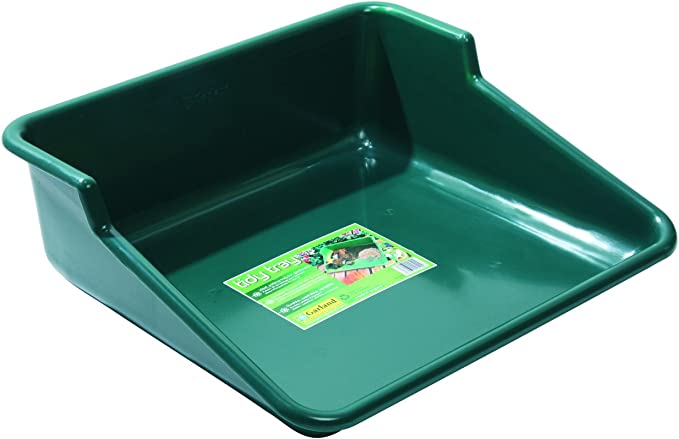- Home
- Caring for Head Tilt Rabbits
Caring for Head Tilt Rabbits
Key Points:
- Caring for head tilt rabbits may involve simple alterations to the living environment, such as putting in a low-entry litter box, or it could involve syringe-feeding every few hours. It depends on the disease and the individual rabbit.
- The caretaker should keep these 3 questions in mind: Is my bunny comfortable? Is my bunny clean? Is my bunny dry? The answer to these 3 questions will guide your care routine.
- Although it is important to confine a head tilt bunny in the first couple of weeks, owners should encourage the bunny to exercise as soon as possible. Standing, moving and exploring will engage those areas in the brain that control balance and speed up recovery.
Caring for Head Tilt Rabbits: the First Weeks
Caring for head tilt rabbits can be as easy as administering medications and providing a low entry litter box in the pen, or more demanding, requiring syringe-feeding every few hours. How much supportive care your rabbit needs, depends on the cause of the disease and the individual bunny itself.
Usually the first sign a caretaker might notice is a bunny stumbling in his pen or living area. Although head tilt is not an immediate middle-of-the-night emergency, veterinarian help should be sought out as soon as possible. The quicker your bunny can start on medical treatment, the quicker he can recover. A same day or next day appointment should be made. If you need to wait longer, bring your bunny in as an emergency.
The Initial Pen Set-Up
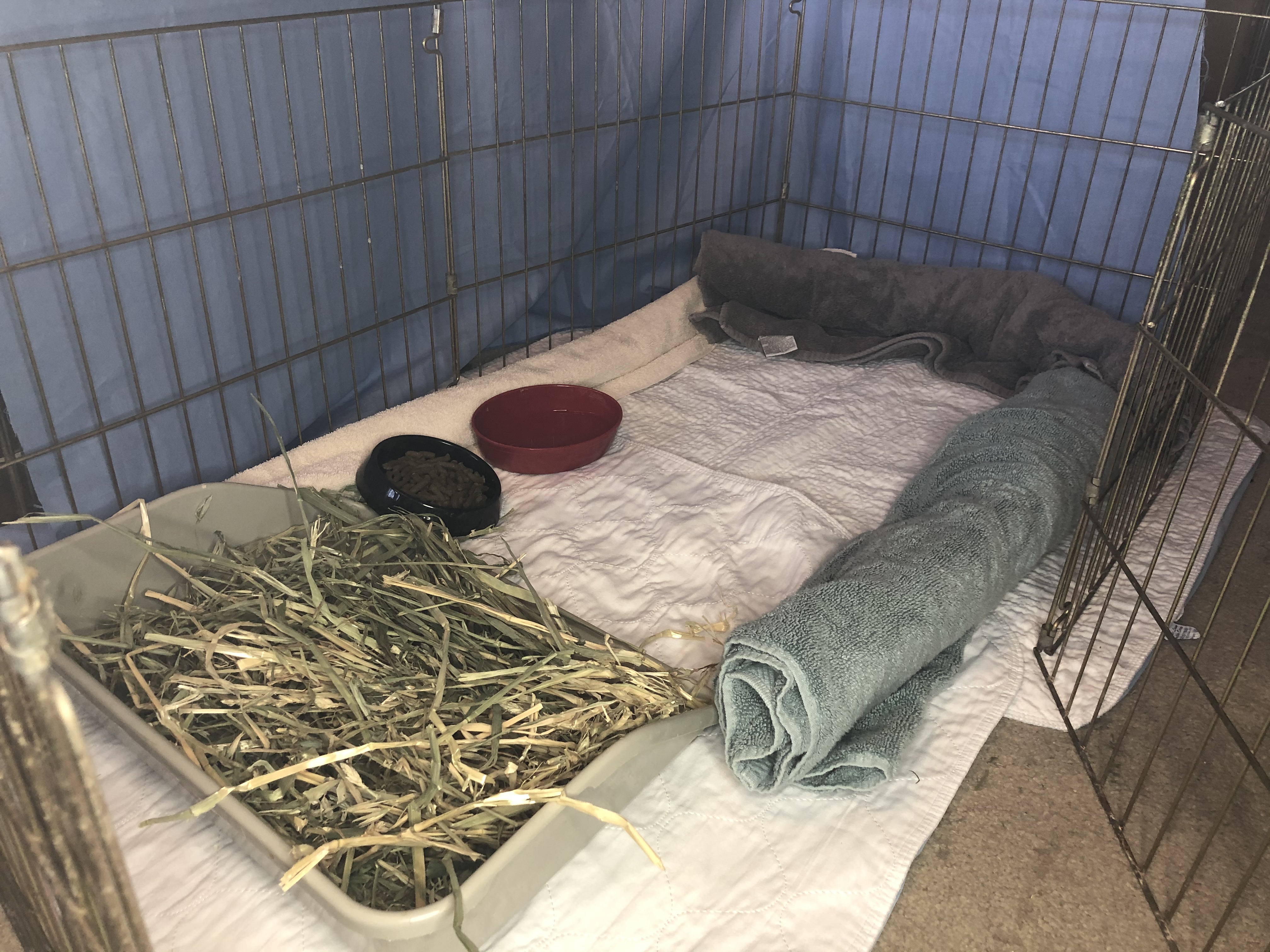 2x4 exercise pen with rolled up towels on the side to cushion the bunny if he rolls. There is a low entry litter box and I'll put in a cardboard box for the bunny to hide in (not shown).
2x4 exercise pen with rolled up towels on the side to cushion the bunny if he rolls. There is a low entry litter box and I'll put in a cardboard box for the bunny to hide in (not shown).Depending on the severity of the tilt, you may need to make considerable adjustments to the living environment. A reduction of the space helps your bunny reach the food and water while limiting the risk of rolling. Usually a 2x4 exercise pen is fine for one or two bunnies; extend it slightly if you have a trio. If your bunny happens to live in a large group, chose his favorite friend (you can also rotate friends every few days) and have the pen right next to the main group. Do not chose the bully in the group for obvious reasons.
This is one of the few times you may need to install a water bottle rather than a bowl. In a severe tilt, you don't want your bunny to fall into his water bowl and have trouble saving himself. Give your bunny a cut-out litter box. If you do not have a low entry litter box, you can purchase one online or you can simply put the hay on the floor.
Keep in mind that this sort of pen set up is only temporary. As soon as the bunny shows signs of stability, the caretaker should encourage the bunny to exercise. This means expanding the space and allowing the bunny to explore outside of the pen, supervised. The increased activity encourages healing and the potential for a faster recovery.
How long a bunny should be confined depends on the individual bunny and severity of the tilt. It's important to work with a rabbit-savvy vet who can guide you.
Dealing with special needs can require some creative problem-solving on your part. The vast majority of items typically found in the small pet aisle of your local pet store will not be helpful. One solution is to reach out to your local rabbit rescue, vet or even some of the rabbit groups on social media. These are people who understand what you are going through and can give you helpful tips and ideas. You may soon find yourself wandering into a hardware or gardening store to see what you can use for your bunny.
For Those Bunnies Who Roll
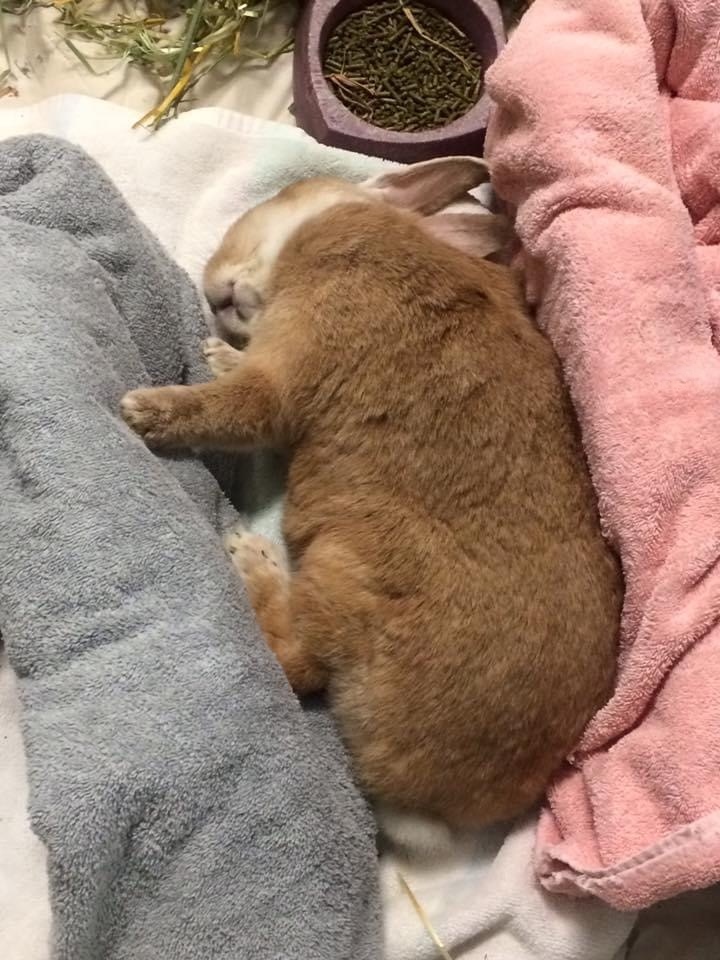 When a bunny can't seem to stop rolling, try using patio bricks rolled in towels to give your bunny some stability. Patio bricks that are rectangular with a long, flat surface gives the bunnies something solid to brace themselves against.
When a bunny can't seem to stop rolling, try using patio bricks rolled in towels to give your bunny some stability. Patio bricks that are rectangular with a long, flat surface gives the bunnies something solid to brace themselves against.Towels are very useful to roll up and line the side of the pen or between the litter box and the pen wall (so your bunny doesn't somehow get trapped in between) as well as give your bunny something warm and soft to lie on. Be sure the bunny does not get his paws or legs caught between the pen bars. A bunny can easily panic, making the situation worse. During the thrashing, he can break bones.
Make sure all bedding does not have any holes! As tilt bunnies roll, gaps in the torn bedding catch limbs and act as a tourniquet, cutting off blood supply to the extremities. These bunnies cannot control where they will fall and/or roll, nor can they control how quickly they will find their feet and regain their balance. They quickly become entangled in a frayed sheet or torn hole and get hurt.
Make sure the bunny has a good grip on the flooring. Sliding around on a slick floor, does not help the bunny keep his balance. Fasten blankets, towels or sheets to the pen with clips or use rugs with a rubber or vinyl grip on the underside to help keep the rugs in place.
Bedding
If your bunny is severely tilted and reluctant to move, you need to change his bedding more than once a day to prevent the bunny from laying in urine and developing urine scald, which burns the skin. If the problem is not addressed, the skin breaks down and infection sets in. The risk of flystrike also increases when a bunny can't keep himself clean. Washing and drying a bunny is difficult, since the stress of being handled will cause him to lose balance and roll. In the first few weeks, minimize handling as much as possible to aid in a quicker recovery.
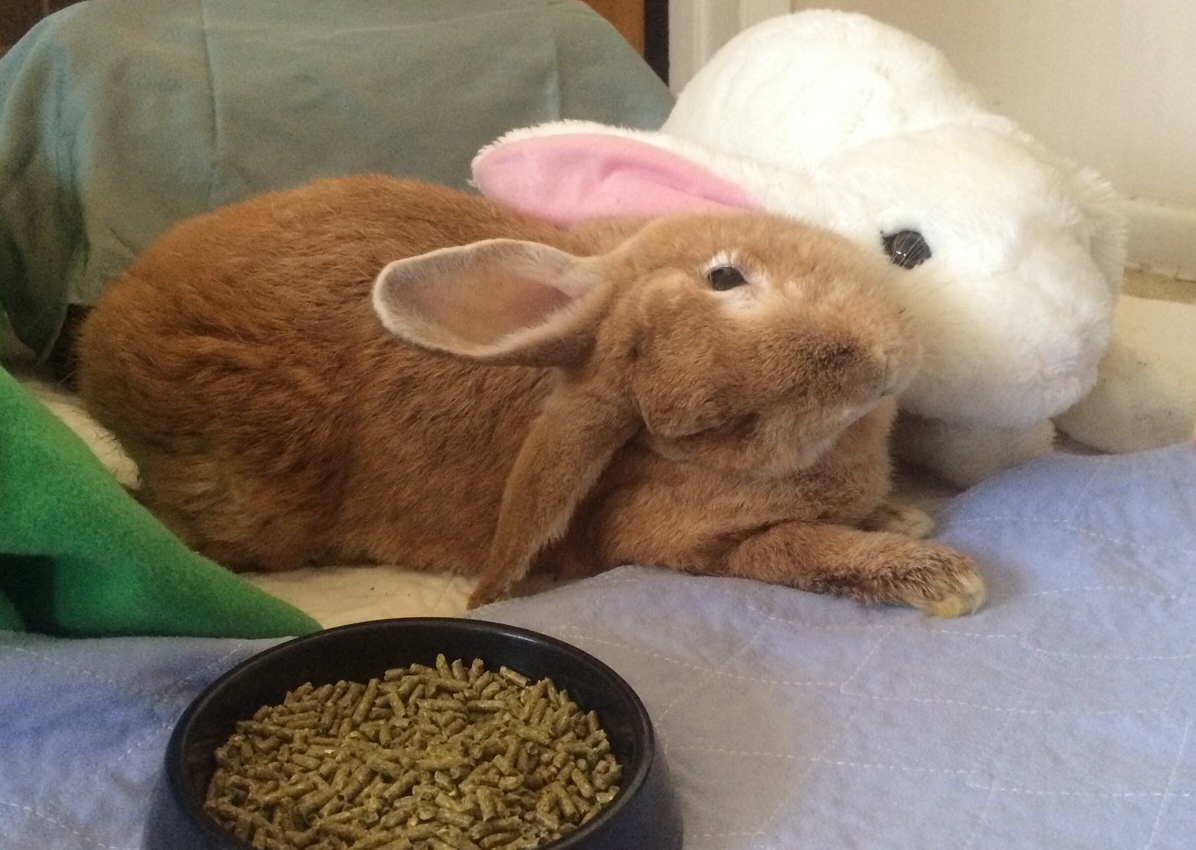 Poppy and her best bud, Oscar.
Poppy and her best bud, Oscar.Unfortunately, towels are not adequate for this situation, but there are a few other bedding options available to you:
- Microfiber fleece. If you have even basic sewing skills, you can purchase microfiber fleece at your local fabric store and make your own fleece pillows. There is usually a wide variety of colors and patterns available. Polyester batting (the type quilters may use for their projects) is inexpensive. You can make the pillows any size or shape to suit your needs. The microfiber fleece is machine washable.
- Bathmats. Many bathmats are made out of microfiber material and absorb moisture very well. The mats can easily be machine washed. However, they are not a good choice if you have a serious chewer.
- Vet bedding. This is 100% polyester fleece, that may be sold as faux sheepskin, vet or pet bedding. It wicks away moisture, leaving the bunny clean and dry. This sort of bedding can be used all day without being replaced. It's machine washable and can quickly air dry. This type of fleece is available at the following places:
 Microfiber fleece blanket. Even if you don't have a sewing machine, you can hand-stitch the sides together. Microfiber fleece blanket. Even if you don't have a sewing machine, you can hand-stitch the sides together. |
 Polyester batting is more durable than cotton. Once the batting is stitched closed within the fleece, you have a nice bed for your bunny. Polyester batting is more durable than cotton. Once the batting is stitched closed within the fleece, you have a nice bed for your bunny. |
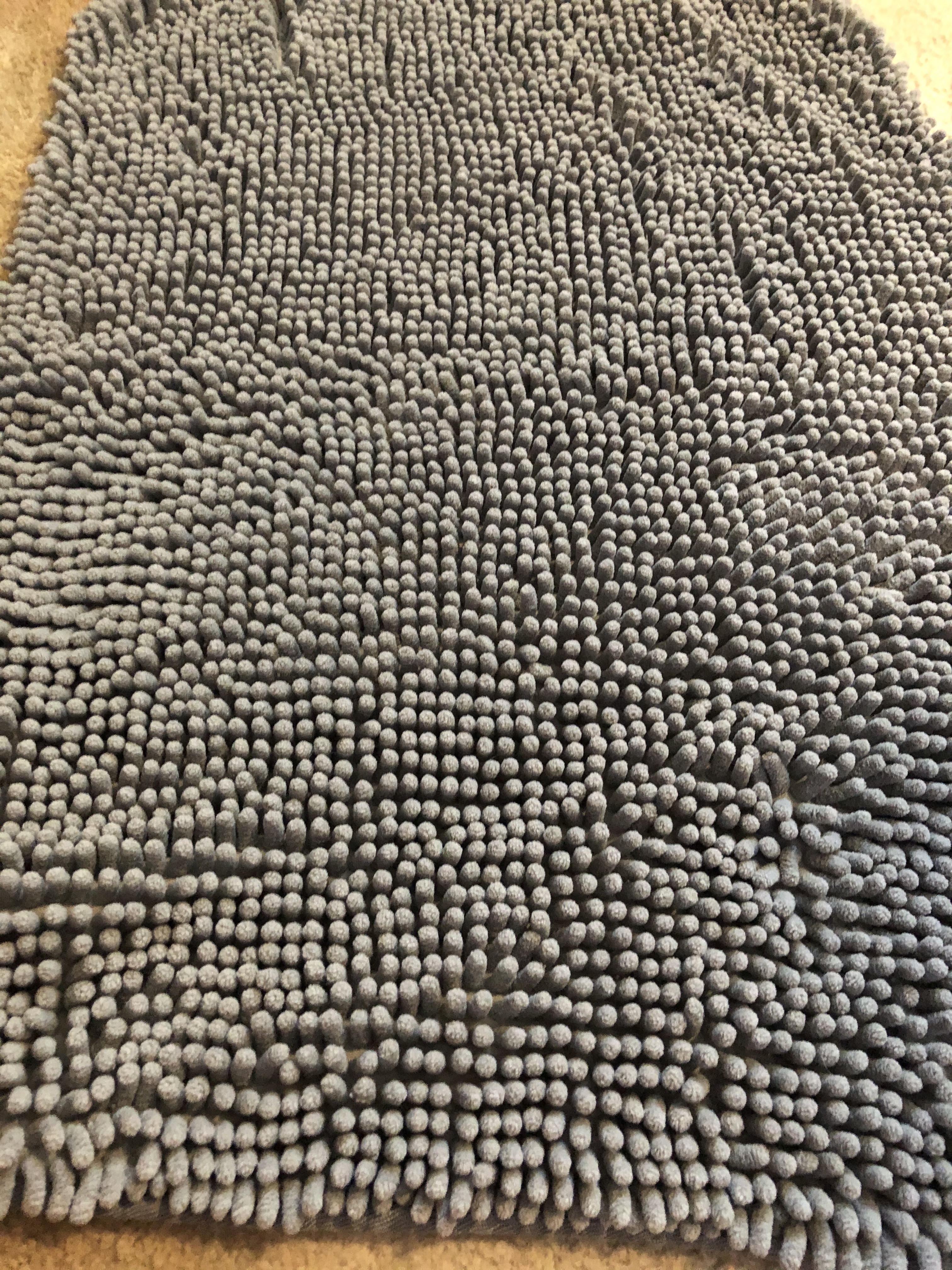 A bath mat can be a good choice, if your bunny does not have an interest in chewing it. This particular mat is excellent in drawing moisture away from the bunny. A bath mat can be a good choice, if your bunny does not have an interest in chewing it. This particular mat is excellent in drawing moisture away from the bunny. |
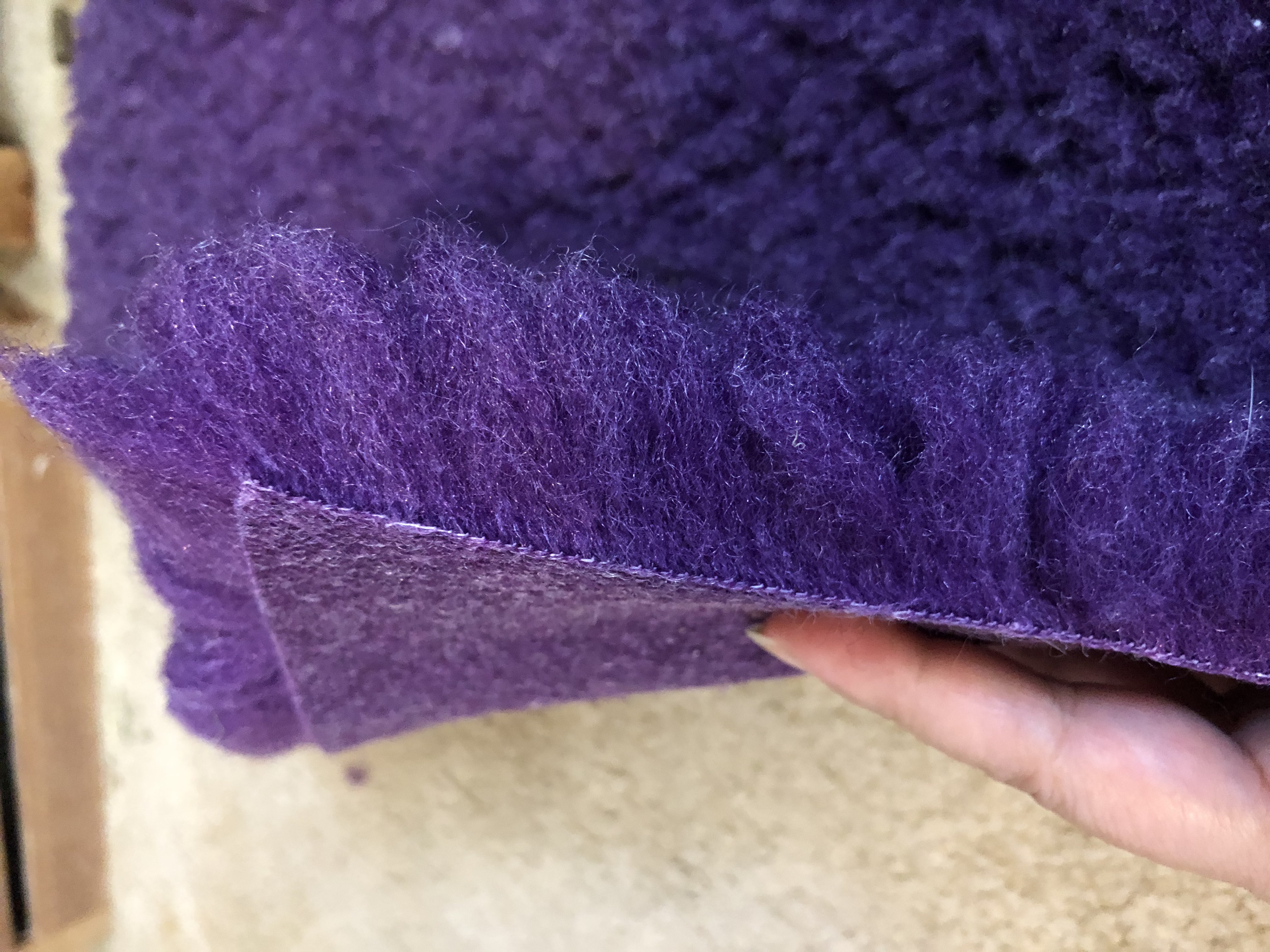 Vet bedding can come in different sizes and colors. The fleece is thick, which ensures the bunny is comfortable and dry. Vet bedding can come in different sizes and colors. The fleece is thick, which ensures the bunny is comfortable and dry. |
Supportive Care
How much supportive care you need to do will depend on the situation. If your bunny wobbles around his pen, shows interest in his food and is able to eat and drink on his own, you probably do not have to worry about syringe-feeding. Your vet may still want to supplement fluids, but that depends on several factors such as the severity of the disease as well as your willingness to administer sub-q fluids (meaning injecting fluids just under the skin in the back of the shoulder area). Your veterinarian can show you how it's done. Sub-q fluids are a reliable way to keep your bunny hydrated when he has trouble eating or drinking. Sub-q fluids are usually only given in the first few weeks, not for the entire duration of treatment.
If your bunny is unable (or unwilling) to eat, syringe-feeding will be necessary. There are a number of powdered supplemental feeds on the market. Sometimes you need to add more water than recommended in the directions to prevent clumping in the syringe. If your bunny is not happy with the food, mix with a bit of apple juice to give it some flavor. Talk to your vet as to how much you should feed your bunny daily.
Syringe-feeding tips:
- Take your time. It's very easy for your bunny to choke, so be patient and go slow.
- Always angle the tip of the syringe to the side of mouth. Pointing the tip straight back of the throat increases the chance of choking.
- If your bunny cannot take a few steps to eat on his own, do not pick him up so you can feed him in the bathroom. Feed him in his pen.
- It will be messy. Wear old clothes and use a damp paper towel or washcloth to clean his face.
- Usually, it's better to do smaller feedings more frequently throughout the day rather than just one or two big feedings. Stress will cause him to roll.
- Feed as much as bunny wants. If the goal is 20ml, and he wants 30ml - great. If he just wants 10ml and refuses any more, take a break and try again in 20 min or so.
If your bunny is willing to eat Critical Care (or any other supplemental food) from a bowl, you have another few options available to you:
- Soak pellets, add some Critical Care and mix well.
- Mix Critical Care with some applesauce, pumpkin or baby food (mix fruit varieties only, such as pumpkin/banana or strawberry/apple, etc.).
Serve in a small bowl the bunny can access or you can try and spoon-feed.
Medicating your Head Tilt Rabbit:
|
When it's time to medicate your bunny, slowly approach him in his space. Here, I am taking my time to make both the bunny and myself comfortable. |
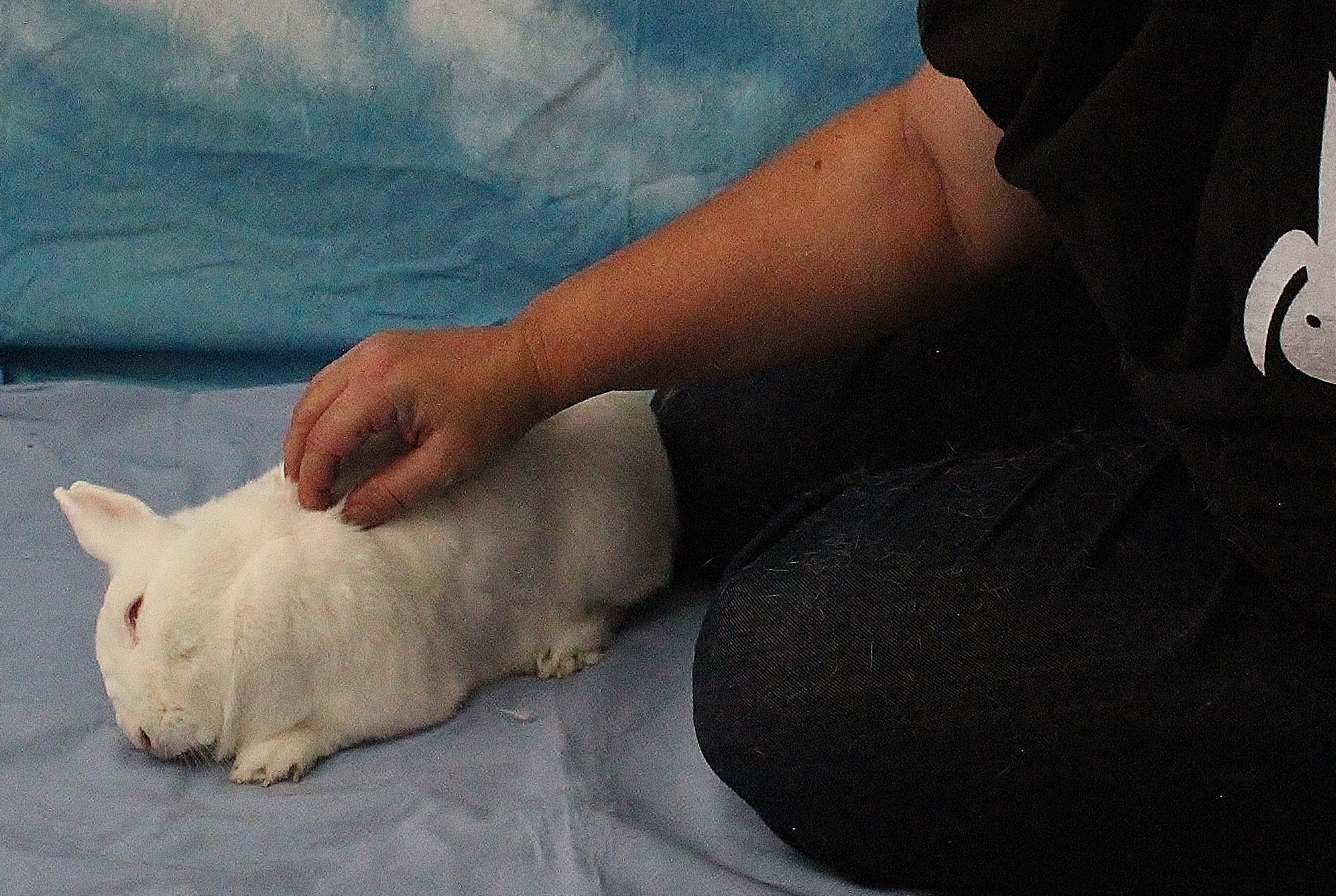 Making Lucas feel comfortable around me. Making Lucas feel comfortable around me.Photo by Tim Zerkel |
|
Either position yourself over the bunny or slowly slide your bunny in between your legs. Here, I turned Lucas slightly to get him into a better position. During this time, I continued to pet and talk to him. |
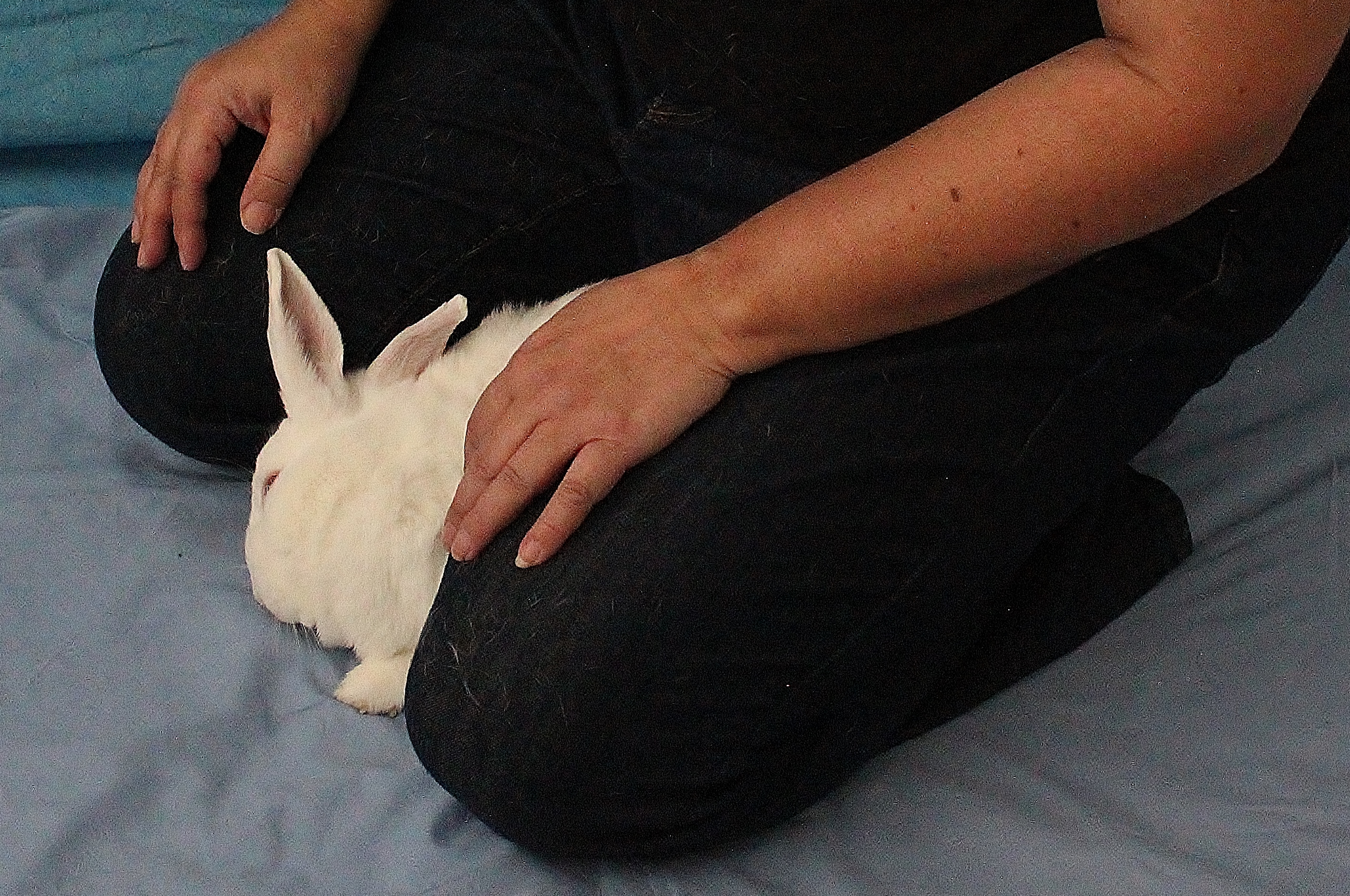 Photo by Tim Zerkel Photo by Tim Zerkel |
|
Use your legs and knees to steady your bunny and to prevent him from either rolling or running away. All of your weight should be resting on your heels. At no point during the session, should you be sitting on your bunny. |
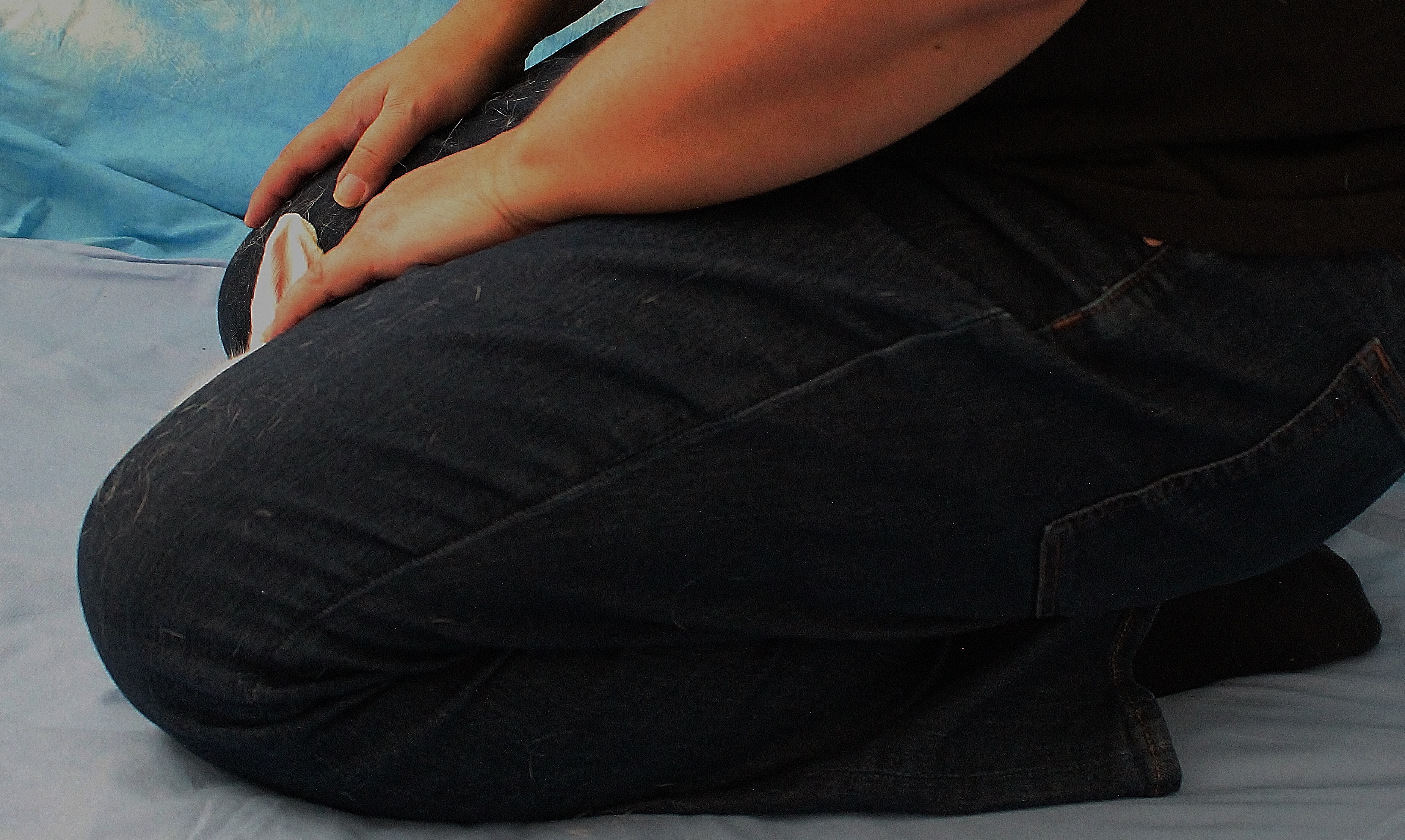 Photo by Tim Zerkel Photo by Tim Zerkel |
|
This is another view of my hold. Since I'm resting my weight on my heels, I'm also preventing the bunny from backing away and making his escape behind me. This concern is less important for head tilt bunnies than medicating those who are more mobile. |
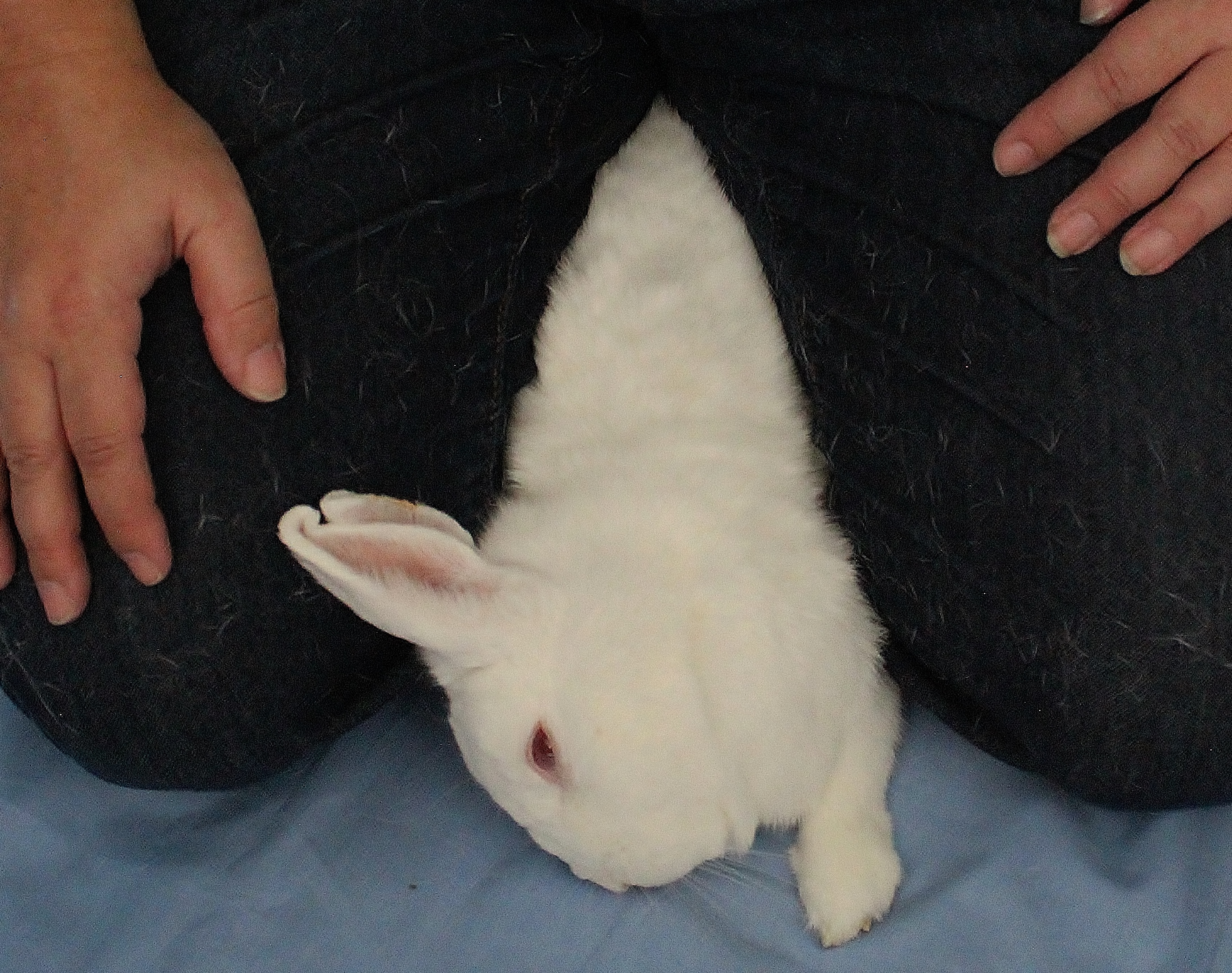 Photo by Tim Zerkel Photo by Tim Zerkel |
|
My right hand has a claw-like grip on his head. This allows me to have better control. With my pinky finger, I can lift up his upper lip and slide the tip of the syringe in the gap of his teeth (between his front incisors and molars). |
 Photo by Tim Zerkel Photo by Tim Zerkel |
|
Even sweetened, bunnies don't always like their oral medication. Go slow and take your time. You don't want your bunny to choke. Once finished, praise your bunny and give him a treat. Slowly, allow your bunny to move away. Steady him if he looks like he may fall. |
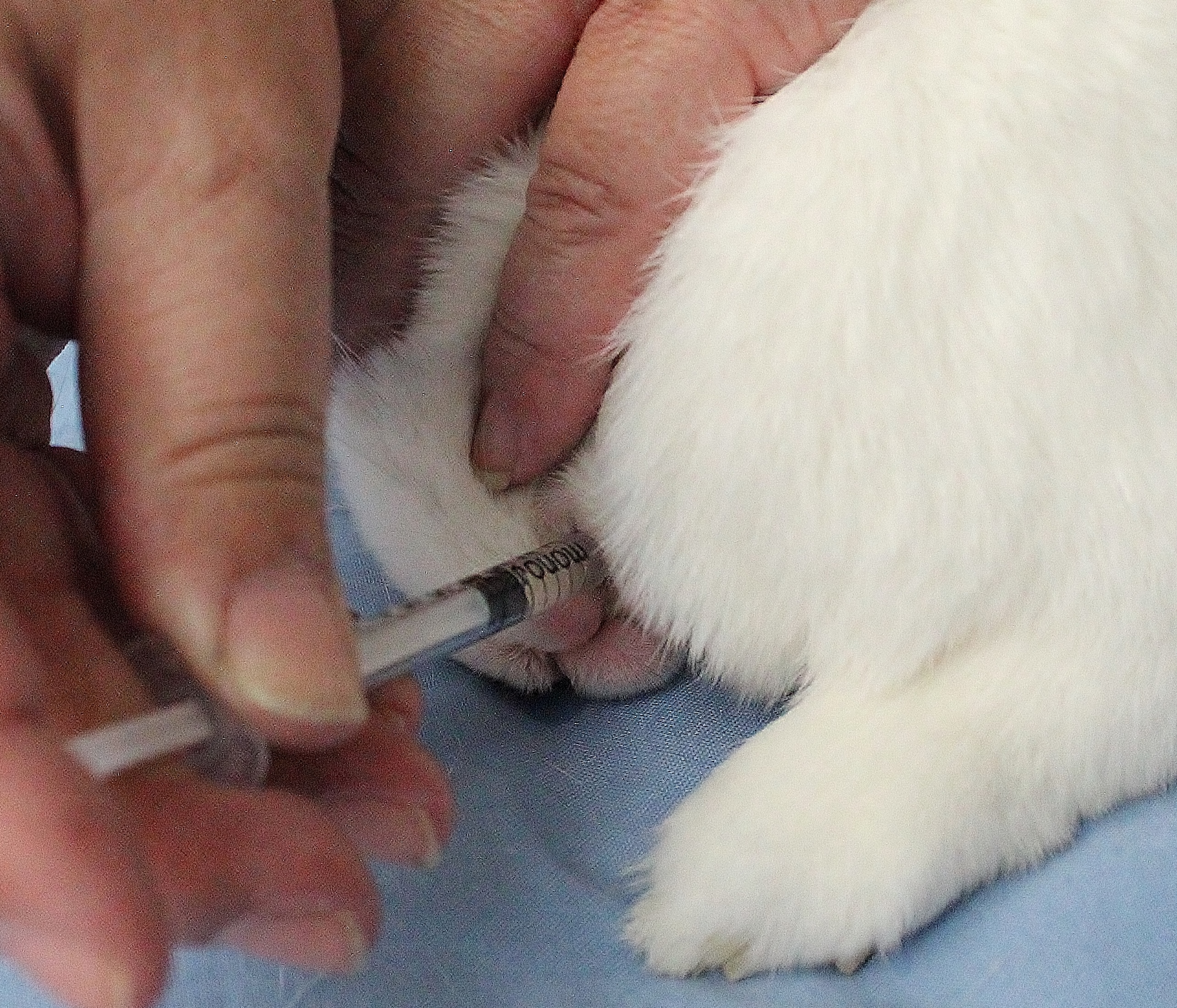 Photo by Tim Zerkel Photo by Tim Zerkel |
Handling
In the first few weeks of the illness, handle a head tilt rabbit as little as possible. The movement of the feet and sudden positional change in the head can aggravate those areas in the body which effect balance. Coupled with stress, the bunny will roll.
However, you cannot avoid handling completely.Whether it is a trip to the vet or you need to move him a couple of inches to better feed and medicate him, you will need to do some handling.
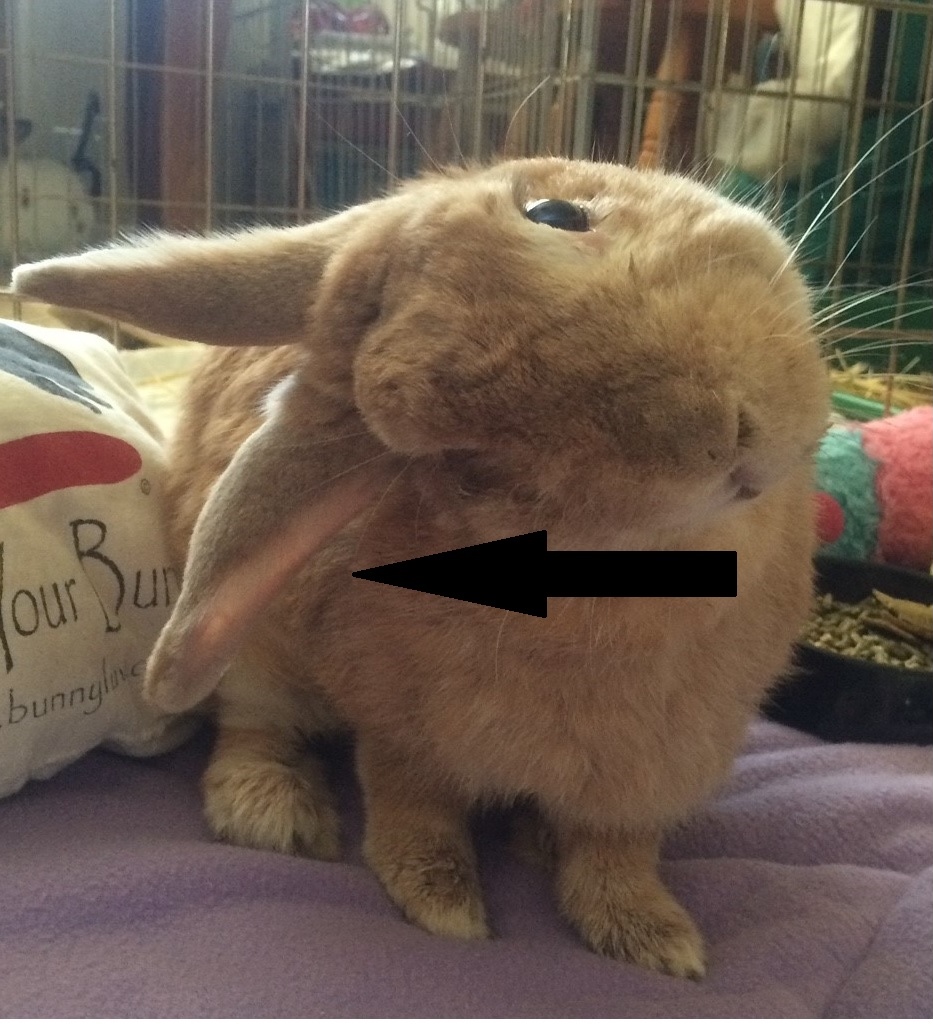 Poppy has her head tilted to the right. If she is going to roll, she will move to the right. Therefore, I need to support that side, so if she decides to roll, she will roll into me, instead of away from me and off my lap.
Poppy has her head tilted to the right. If she is going to roll, she will move to the right. Therefore, I need to support that side, so if she decides to roll, she will roll into me, instead of away from me and off my lap.Rabbits can tilt their heads to the left or right (one side isn't worse than the other). If a rabbit it going to roll, he will roll in the direction of his tilt. Stress, standing, walking, changing the position of the head and/or feet can all cause a bunny to tumble.
If your bunny is on your lap, make sure your bunny is positioned to roll into you, if necessary. That way, your body stops the roll and helps the bunny find his feet. If you have it so the bunny rolls away from your body, you risk the danger of the bunny rolling off your lap.
Sometimes, bunnies give you plenty of warning that they're about to roll - their head seems to twist more than usual, the feet slowly slide out from underneath them and their body leans to the side. The bunny has already started rolling. You're not going to stop it, but you can slow it down and help the bunny find his feet again. Brace your forearms to either side of the body and slowly guide it through the motion (think about when your gym teachers taught you how to do a sommersault as a kid in gym class. They put their hands on your neck and back and guided you through the move). Sometimes the bunny will roll several times in a row. You are there to make sure he doesn't hurt himself.
Keys to handling:
- Support the neck and head.
- The other hand should support the back legs.
- Use your body! Leaning your bunny against your body will help make the bunny feel more secure.
- When setting back down, make sure your bunny can find his feet before letting go.
Click here to see the video.
|
When picking up a rabbit with head tilt, make sure you not only support the back feet, but you also support the neck and head. Even though Aria is stable with her tilt, I want to minimize how much I move her because picking her up will still cause dizziness. |
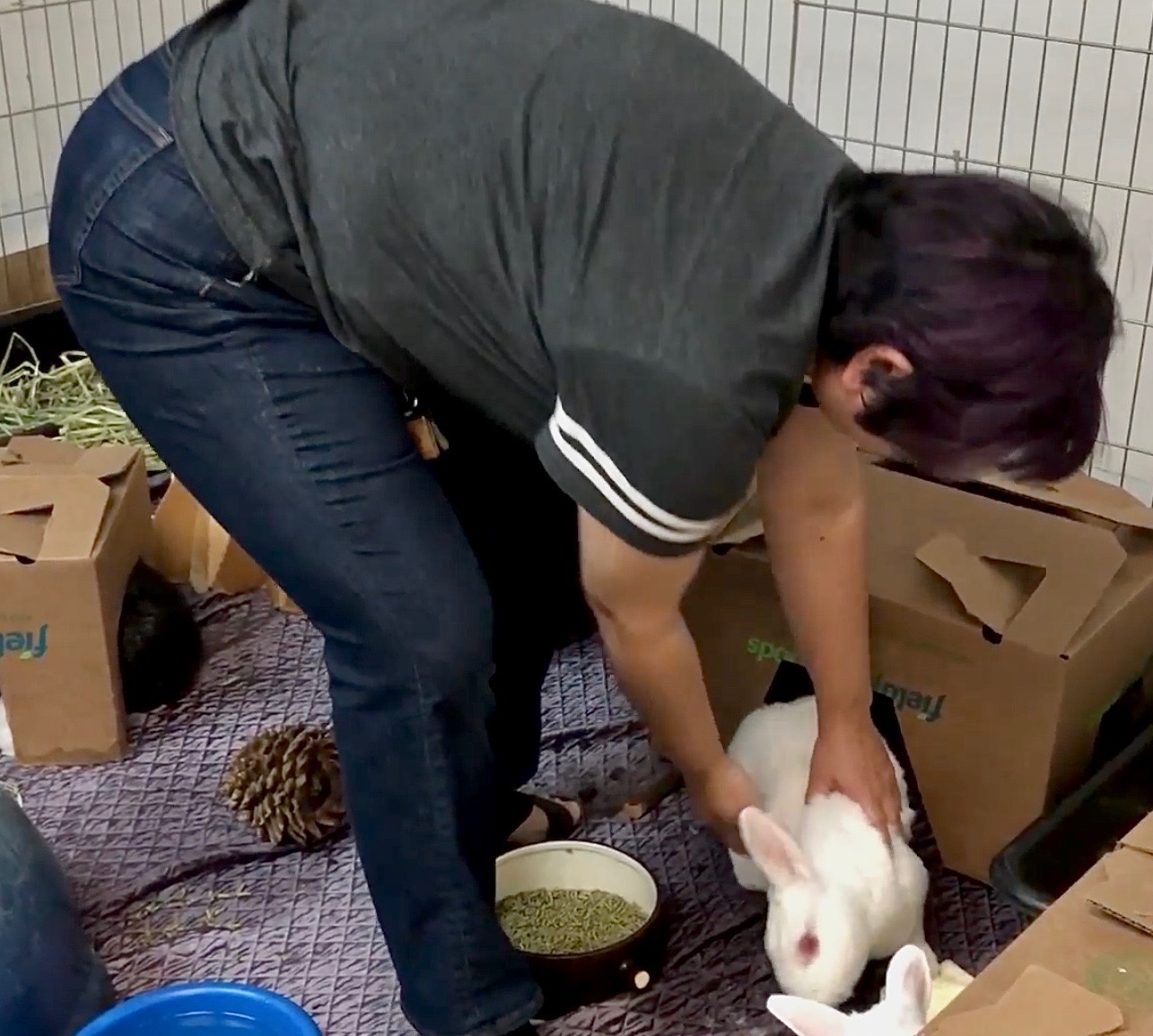 Photo by Tim Zerkel taken at BunnyLuv Rabbit Resource Center. Photo by Tim Zerkel taken at BunnyLuv Rabbit Resource Center. |
|
I'm using my body to secure Aria. If Aria was tilting to the left, I would have her facing the other direction. I have one hand supporting her back legs and back and the other hand is stabilizing her against my body. |
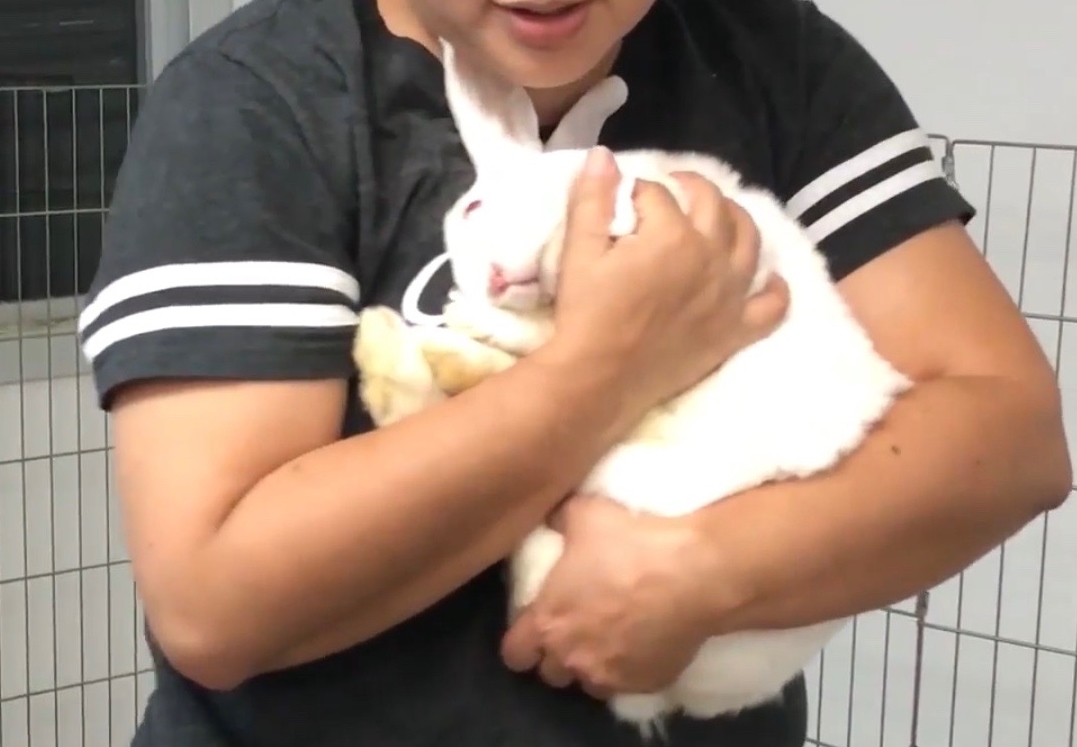 Photo by Tim Zerkel taken at BunnyLuv Rabbit Resource Center. Photo by Tim Zerkel taken at BunnyLuv Rabbit Resource Center. |
|
I'm setting Aria down on my lap. I am still using my body to support her. I want to make sure she has all four feet underneath her before I let her go. |
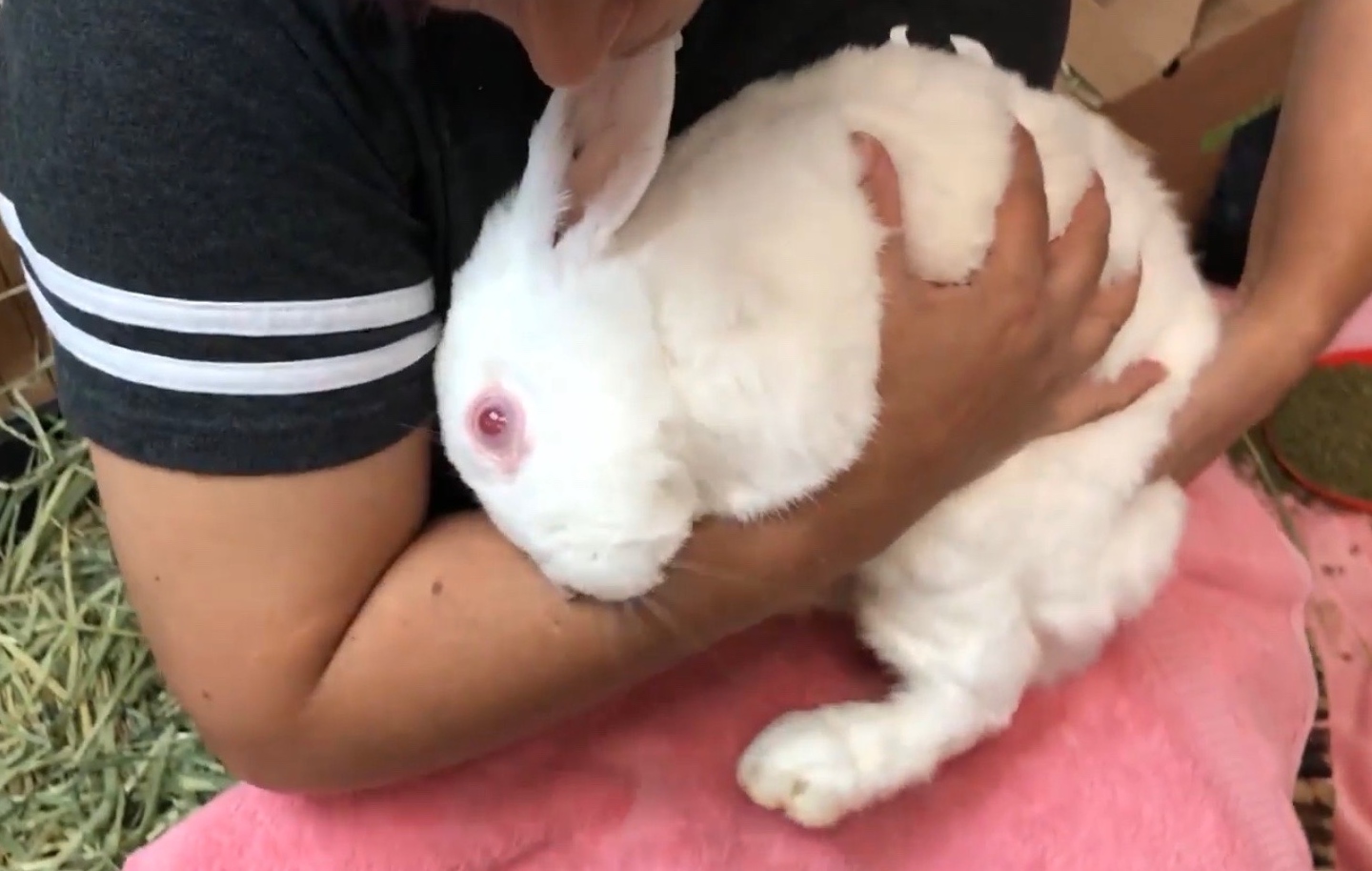 Photo by Tim Zerkel taken at BunnyLuv Rabbit Resource Center. Photo by Tim Zerkel taken at BunnyLuv Rabbit Resource Center. |
|
Even stable head tilt bunnies will roll when handled. Signs they are getting ready to roll is an inability to get all four feet underneath them and their head is severely tilt (almost 180 degrees from normal position). See how Aria's mouth is almost pointed straight up. |
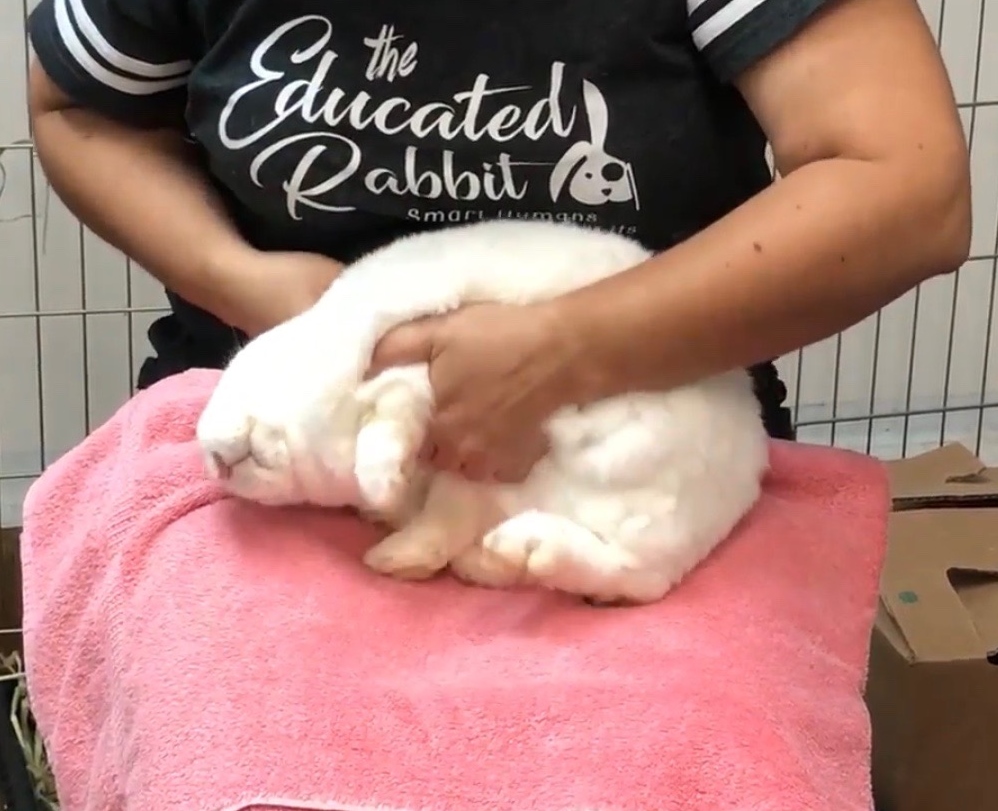 Photo by Tim Zerkel taken at BunnyLuv Rabbit Resource Center. Photo by Tim Zerkel taken at BunnyLuv Rabbit Resource Center. |
|
I am going to support her through this roll. With my hands on either side of her, I can guide her safely through the roll. For added support, she is rolling into me. |
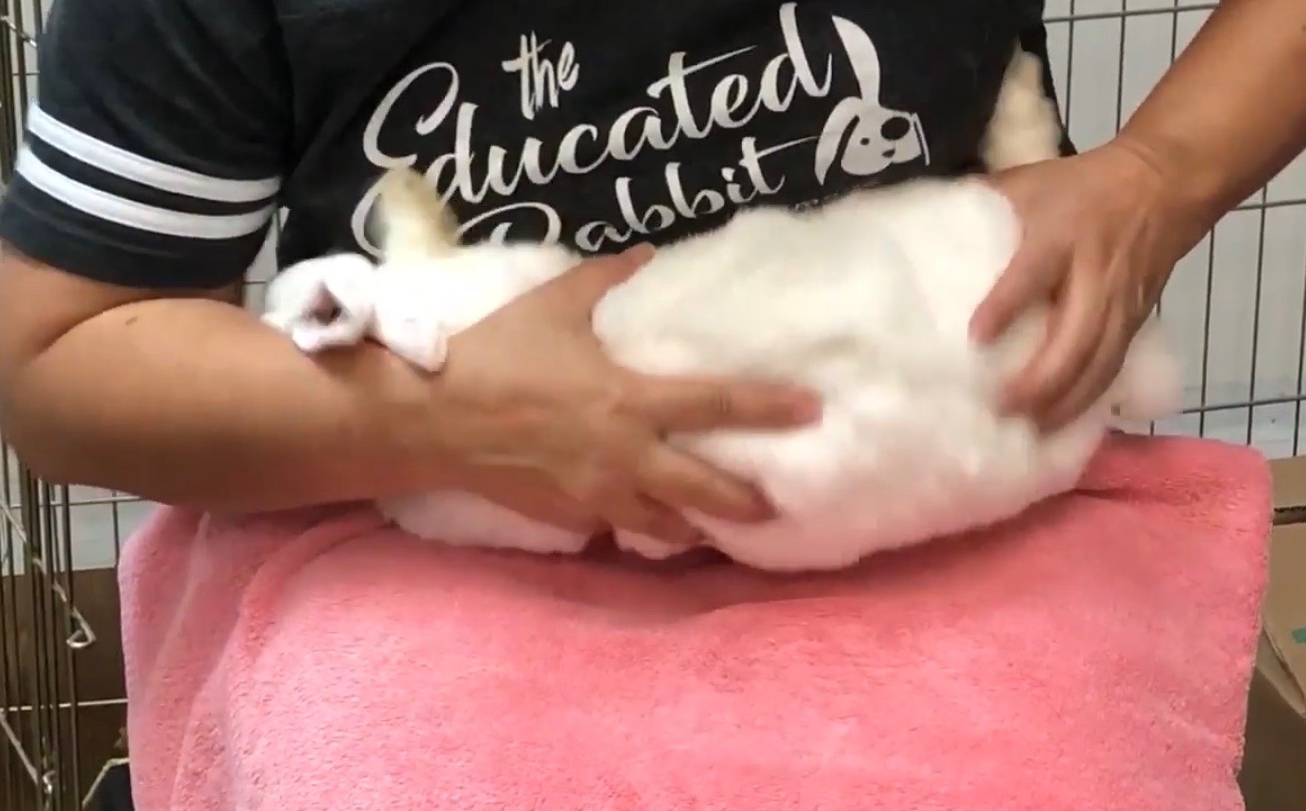 Photo by Tim Zerkel taken at BunnyLuv Rabbit Resource Center. Photo by Tim Zerkel taken at BunnyLuv Rabbit Resource Center. |
|
I'm steadying Aria with both hands on either side of her body. I want to make sure she knows where her feet are before letting her go. |
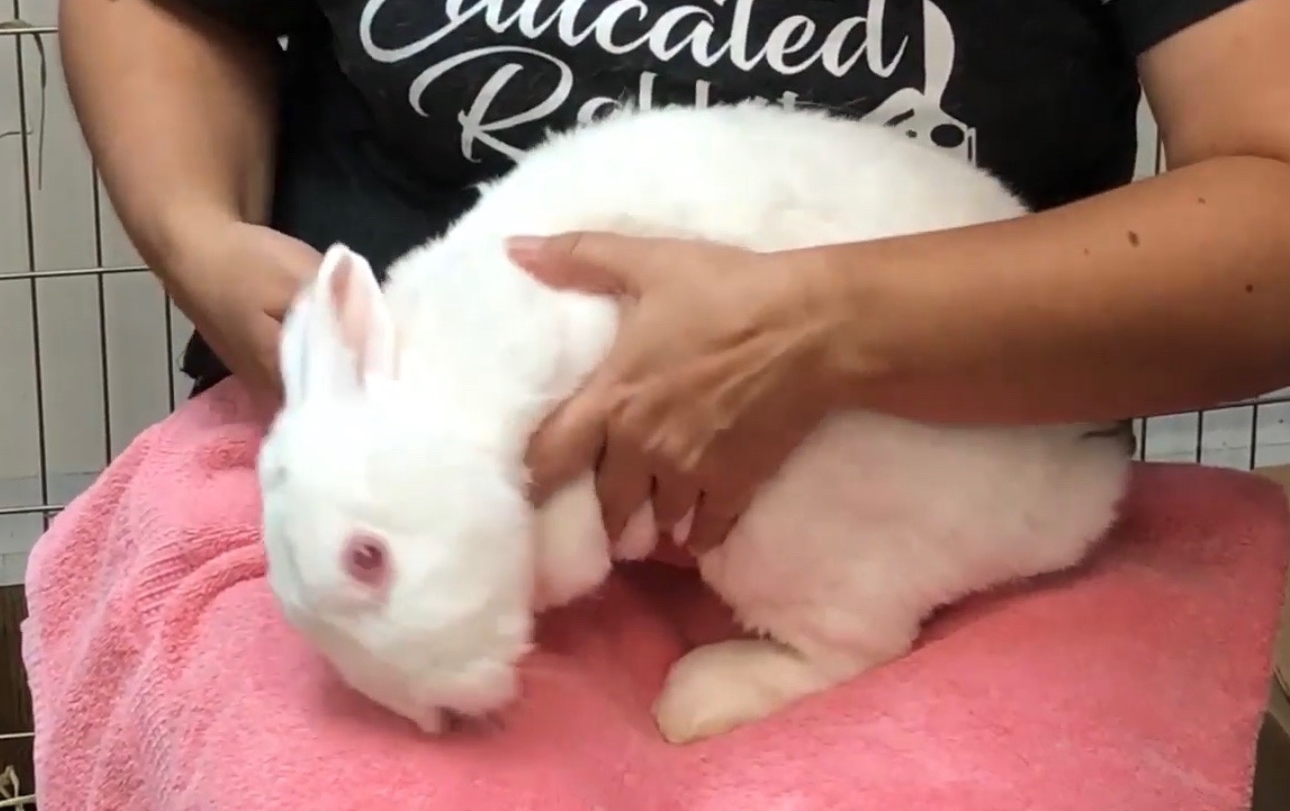 Photo by Tim Zerkel taken at BunnyLuv Rabbit Resource Center. Photo by Tim Zerkel taken at BunnyLuv Rabbit Resource Center. |
|
When I am done, I will slowly set her back down on the ground. I have my hands on both sides of her to buffer her, so she doesn't tumble as soon as I let her go. When I know she has all four feet on the ground and unlikely to roll, I release her. |
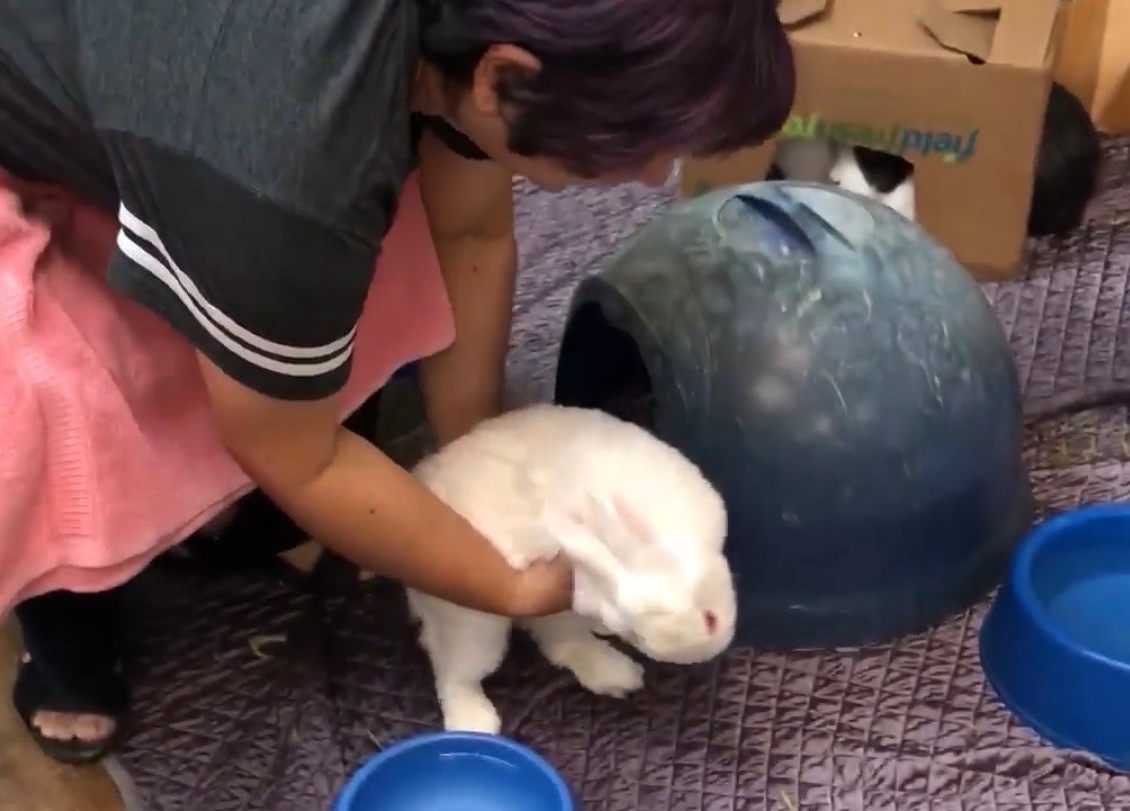 Photo by Tim Zerkel taken at BunnyLuv Rabbit Resource Center. Photo by Tim Zerkel taken at BunnyLuv Rabbit Resource Center. |
The information presented is for educational purposes only and does not substitute veterinarian care. This information should not be used for diagnostic purposes, for treatment of an illness or injury and never should be substituted for veterinarian care by a licensed veterinary practitioner. The Educated Rabbit cannot be held responsible for the accuracy of the information contained, nor be held responsible for any action, based on information found in The Educated Rabbit.
Seek advice from your veterinary professional for any rabbit health issues and before administering any drugs!
Available Now!
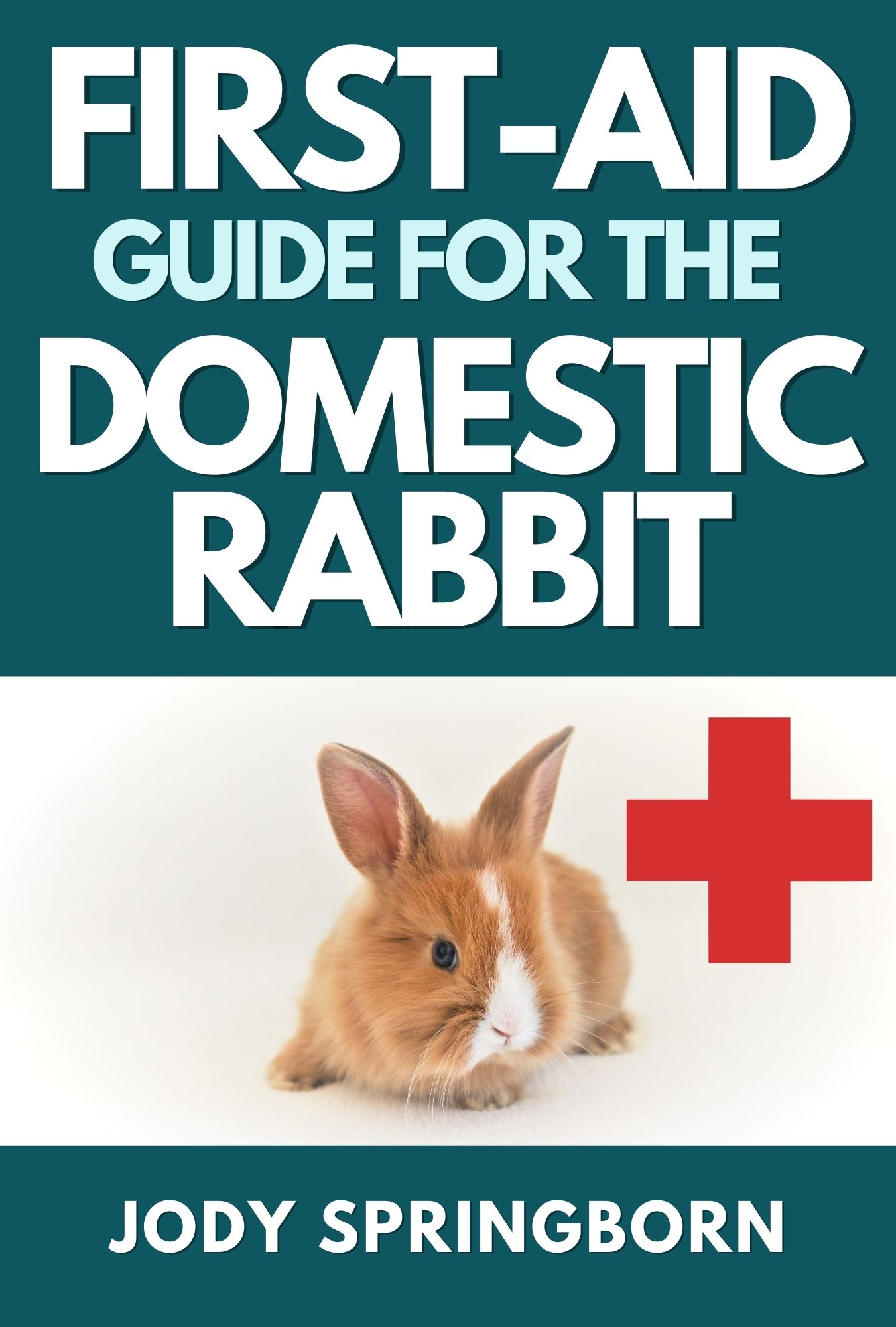
Often times, rabbit health issues require immediate attention. My First Aid Guide for the Domestic Rabbit will show you the most common health issues and teach you the basic skills you should have when your bunny needs you the most. There are over 100 color photos that show you all the supplies you need and how to help your rabbit in easy to follow step-by-step instructions.

